Being 'inspired' by a design is acceptable. But what happens when designers blatantly copy from each other? Is the fashion industry suffering from a creative block?
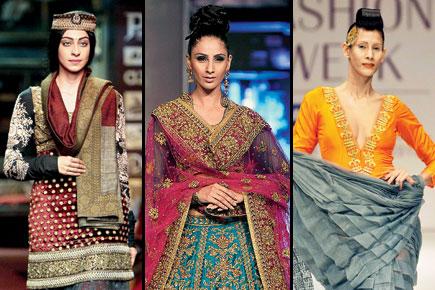
Between 1950 to 1980, it was unheard of. But in the 1990’s, piracy reared its ugly head when fashion institutes and a blitz of trained designers, high fashion stores and retailers started mushrooming all over India. Rip offs, copies whatever you call them exist all over the world but in India it was in its infancy but very much rampant.

Creation by Tom Ford, who is known to have been inspired by Geoffrey Beene’s 1967 version of the jersey dress
ADVERTISEMENT
It’s more noticeable now with intense competition when nearly 10,000 fashion graduates each year want to grab mega bucks and not all are necessarily creative. Designers Abu Jani and Sandeep Khosla, for instance, have been victims of piracy when many of their designs were ripped off, even as some other designers argue that a charge of plagiarism can’t be thrown at a person unless it is proven that not just a concept but a complete design has been copied.
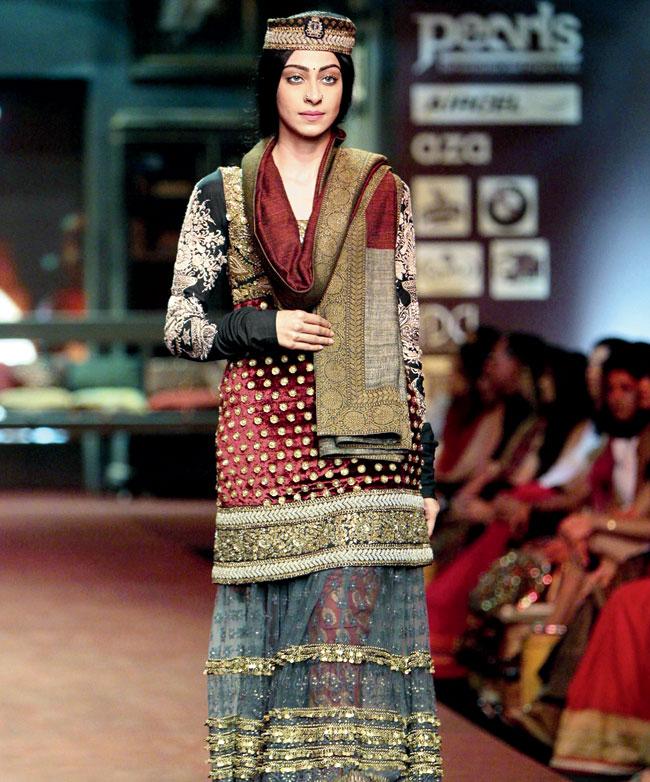
A Sabyasachi Mukherjee creation. Pic/AFP
The siege within
One designer who is a favourite of the copycats is Padmashri Ritu Kumar. The doyen of Indian fashion became an unwilling and unwitting supplier of designs to the fashion pirates in the past decade. She says even copies of her creations were hung right opposite her outlet and passed off as her originals. Finally Kumar won a case in 2006 against one Nina Talukdar of Kolkata, for piracy.
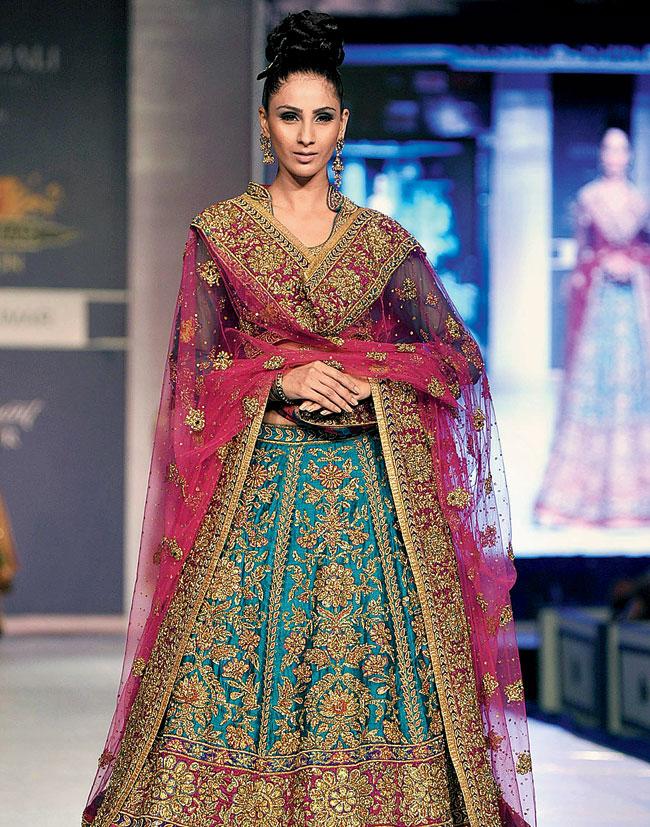
A model showcases a creation by designer Ritu Kumar at Rajasthan Fashion Week 2013. Kumar won a case in 2006 against Nina Talukdar of Kolkata, for piracy. pic/ AFP
The owners of Monapali — the Kolkata-based fashion label run by Mona Lamba and Pali Sachdev, too, have seen some of their best creations being copied and sold all over the country as ‘originals’. Others such as Tarun Tahiliani, Sabyasachi Mukherjee, Rohit Bal, JJ Valaya and even new stars such as Masaba Gupta complain that their works have been blatantly copied and sold at far cheaper prices.
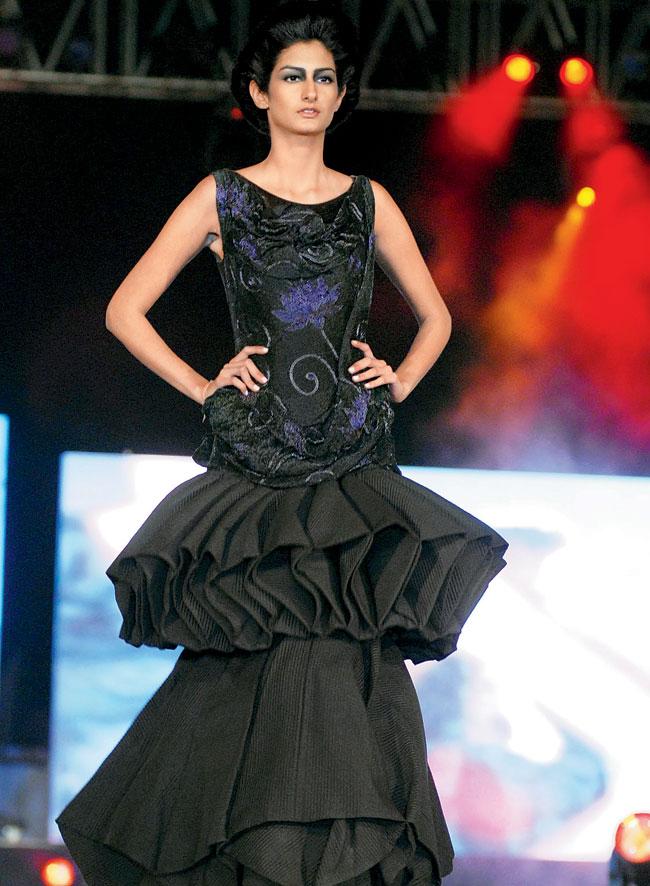
A model walks the ramp showcasing the creation of designer Rohit Bal during Oriflame Fashion Show in Delhi. Bal is one among many designers who have complained that their works have been blatantly copied and sold at far cheaper prices Pic/File Photo
Concerned about piracy Tahiliani says, “I am very worried about copying, which is a huge problem today. But honestly, there is nothing much we can do about it except make the clothes more technically complex. It is not about sales figures and my profits alone. But when someone wears a bad copy of my creation, then people think I have designed it, which affects my reputation.”
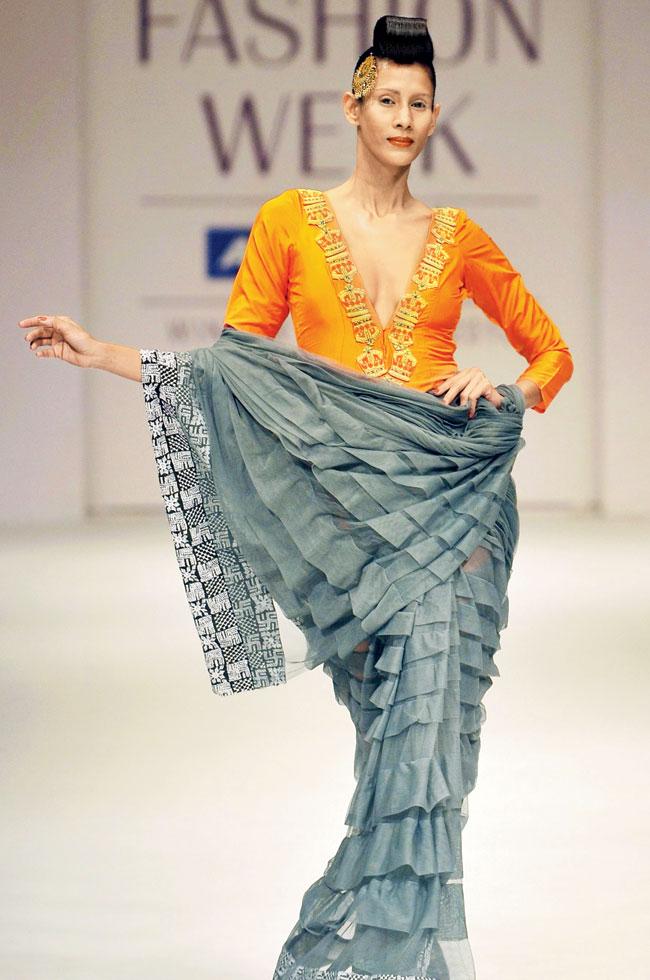
A Lakme Fashion Week (LFW) Winter/ Festive 2010 creation by fashion designer Masaba Gupta, one of the newer designers to complain about the rampant plagiarism in the industry. Pic/AFP
There have been instances when assistants of top designers have walked off with paper patterns and client contacts to set up a rival business.
Of course, the designer fraternity itself has seen a few hiccups within. Suneet Varma’s 1991 collection, some critics felt, bore a close resemblance to Gianni Versace’s line. But the tables turned when Varma accused Aki Narula in 2005 of copying his outfits for the movie Bunty aur Babli. Narula replied saying his assistant had picked the dresses and the designs from a store. More recently during Lakmé Fashion Week Winter/Festive 2013, designer Shravan Kumar had some prints on his collection, which were identical to those that designer Divya Mohta had used for her garments in 2012.
A global problem
The issue is not limited to India. The famous Yves St Laurent vs Ralph Lauren piracy story in 1994 is a case in point — when the former accused the latter of copying his tuxedo dress design. Yves St Laurent won the case.
The good bit is that some fashion websites, by taking on the role of the fashion police, are highlighting many of these copies and acts of piracy on their sites, helping buyers choose honest designers. Take, for instance, the very popular website intothefashion.com by Diane Marian Murek, a famous fashion forecaster from Instituti Marangoni, Milan. This has daily updates showing the latest works of European and American designers and brands that not only copy from each other but even from their own past collections. Murek highlights how Tom Ford’s Fall/Winter 2014-15 jersey dress looked almost like Geoffrey Beene’s 1967 version and Jane Birkin’s 1970 cropped knit top seemed to appear in D’Squared Spring/Summer 2014 collection.
Very few master craftsmen
In India the limited number of craftsmen who are experts in embroidery, block printing and weaving is an added problem when it comes to creating designs that are not ‘inspired’ or part-copied. Most designers give their garments to the same workers who have half a dozen designers on their client list. With the Internet showing them the latest collections from the world over, it is easier for some to just lift a design instead of toiling hard and coming up with original numbers. High price tags of couture garments also encourage fashion pirates. Fashion houses with five-figure price tags are the haunt of fashion spies who make quick notes or even buy the garments and reproduce them at lower prices at their outlets.
The way forward
Says Aparna Badlani, Partner at Atosa, “A copy is a dress that looks almost the same as the original while an inspiration is when a particular element is interpreted in a designer’s own sensibility. We do get such copies sent by some designers to our stores. While it’s not always easy, sometimes the copies are so blatant that it’s hard to miss. In such circumstances, we return the pieces saying they are too close to another designer’s work we already house at the store. Designers copy for lack of inspiration; it’s an easier way to get noticed. Detecting copies really depends on how well-versed a person is with fashion, how much one reads up and is clued in.”
Agrees Payal Kothari, shoe sculptor at Veruschka. “Collections are accessible at a click of a button allowing designers, retailers and manufacturers to copy and sell great designs at lower prices. The fine line between being inspired and plain stealing is often crossed. Big design houses do extensive research while smaller cash-strapped designers look to these big fashion houses for trends and designs. There is an increased demand for affordable high fashion by the growing middle class. Retailers abroad look at high fashion brands as inspiration to produce mass-market designs. Even designers are influenced by other designers when following current trends,” she concludes.
Copycats
One designer who is a favourite of the copycats is Padmashri Ritu Kumar. The doyen of Indian fashion became an unwilling and unwitting supplier of designs to the fashion pirates in the past decade. She says even copies of her creations were hung right opposite her outlet and passed off as her originals. Finally Kumar won a case in 2006 against one Nina Talukdar of Kolkata, for piracy.
 Subscribe today by clicking the link and stay updated with the latest news!" Click here!
Subscribe today by clicking the link and stay updated with the latest news!" Click here!







